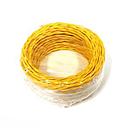Boundary Lead-Out / Dual-Wire (25m)
Cancel the signal so your dog's collar does not activate.
Do you have areas where you don't want your Wireless Dog Electric Fence Boundary Wire to activate your dogs collars?
Sureguard's Australian Made Dual-Wire creates a cancellation of the signal while still allowing the main signal to pass to other areas of your boundary.

Allow your dog to cross this wire
Signal Cancelling Boundary Wire
Do you have areas where you don't want your Wireless Dog Electric Fence Boundary Wire to activate your dogs collars? Sureguard's Australian Made Dual-Wire creates a cancellation of the signal while still allowing the main signal to pass to other areas of your boundary. By deleting the signal, your dog's collar won't activate next to this Dual-Wire.
Why does the signal cancel? It's a little technical, but basically one wire has the signal travelling in one direction and the other wire in the opposite direction. The equal and opposite signals cancel out. In addition, the wires are twisted together to enhance the effect.
Can you make your own Dual-Wire from Boundary Wire? Some say you can by using a drill. However, the result can be frustrating. This method builds stress into the wire and it can be hard to handle. Sureguard's Dual-Wire uses a double spiral winding machine to make an easy to handle, stress free cable.
Note: When ordering this Dual-Wire, please add a Boundary Wire Joiner Kit to your shopping cart.
Boundary Design Examples
Your Wireless Dog Fence boundary can be as simple or intricate as you need. Here are just a few wiring techniques to consider.
Do you have areas where you don't want your Wireless Dog Fence Boundary Wire to activate your dogs collars? Sureguard also makes a Dual-Wire that creates a cancellation of the signal while still allowing the main signal to pass to other areas of your boundary. By deleting the signal, your dog's collar won't activate next to this Dual-Wire.
Note: In these examples we've located the Boundary Wire Transmitter at the house but it can generally be installed anywhere close to the boundary. No matter what design you employ, the boundary is formed by only ONE piece of wire and each end is connected to the Boundary Wire Transmitter.
KEY:


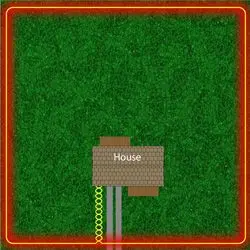
Simple Boundary
1/ Simple boundary design showing a single wire running around the whole property. Notice no signal emitted from the Dual-Wire. Activation distance is constant on each side of the boundary.
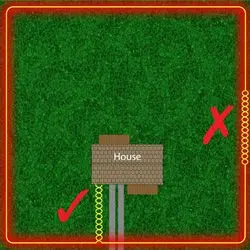
Incorrect Usage
2/ This example shows a common mistake when using Dual-Wire to cancel the signal on the main boundary. It is incorrect because the same signal is being passed in each wire of the Dual-Wire. No cancellation happens. See Example 6 for the correct method.
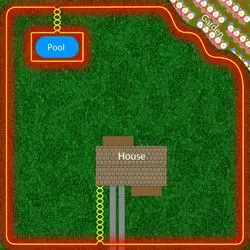
Inner Boundary
3/ Notice the Dual-Wire used to divert signal from the main boundary around a pool area. Your dog's radio collar will now activate around the pool as well as the boundary. Your dog can still walk between the fence and pool and is able to walk across the Dual-Wire.
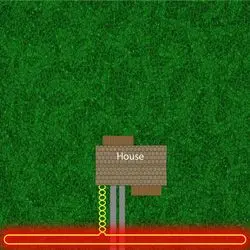
Frontage Only
4/ To protect a single boundary, install a long thin rectangle as illustrated. The width of the rectangle is a minimum 30cm but can be up to 2m should you need greater activation distance. This design may also be used to protect an open gateway, in which case we suggest the rectangle be at least 2m beyond the gate on either side (to stop your dog sneaking past the ends of the gate) and at least 1m apart.
For example, a typical gate is 4m wide. The minimum rectangle size is 4m + 2m + 2m = 8m by 1m or more.
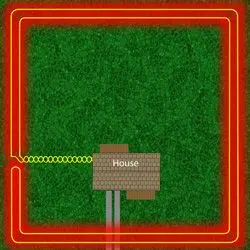
Small Properties
5/ When the minimum dimension of your containment area gets around 10-20m, you must install a doubled wire as illustrated. This design quickly reduces the signal distance to avoid false triggering within the containment area.
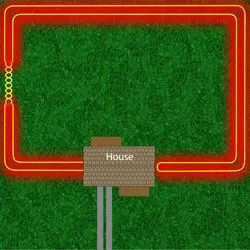
Cancel Boundary
6/ Use the Dual-Wire as illustrated to cancel signal on the boundary.
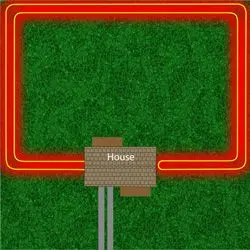
Backyard Only
7/ Doubled wire confines your dogs to the backyard while still allowing your dogs at the back door.
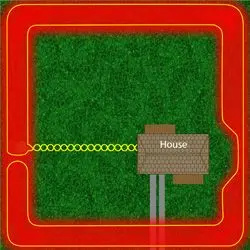
Vary Distances
8/ If you need to reduce the activation distance in certain areas then install the doubled wire boundary and reduce the wire separation. The closer the separation the shorter the activation distance.
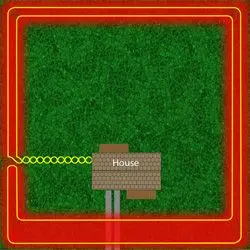
Vary Distances
9/ In this example the frontage has a larger activation distance because the wires are further apart.
-
All Reviews 0 / 0 {'1': 0, '2': 0, '3': 0, '4': 0, '5': 0}
No review available
Write your review
You must be logged in to post a review.
